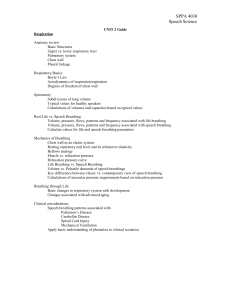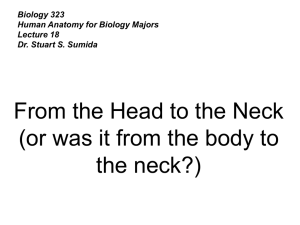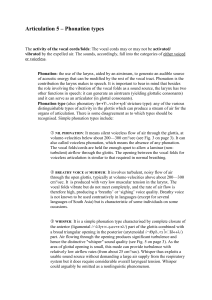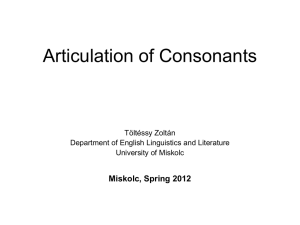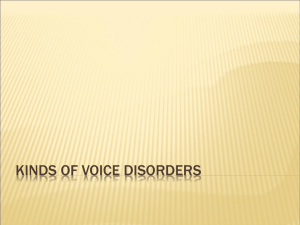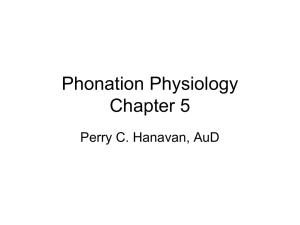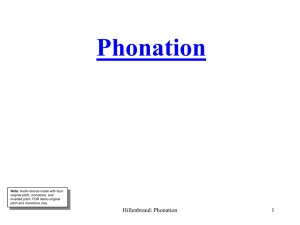The s/z Ratio: Speech Pathology Research & Implications
advertisement
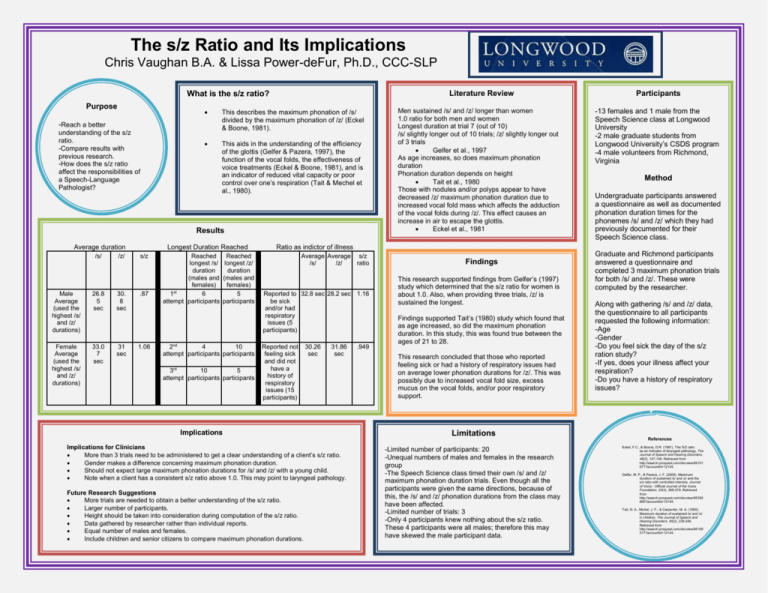
The s/z Ratio and Its Implications Chris Vaughan B.A. & Lissa Power-deFur, Ph.D., CCC-SLP Literature Review What is the s/z ratio? Purpose This describes the maximum phonation of /s/ divided by the maximum phonation of /z/ (Eckel & Boone, 1981). This aids in the understanding of the efficiency of the glottis (Gelfer & Pazera, 1997), the function of the vocal folds, the effectiveness of voice treatments (Eckel & Boone, 1981), and is an indicator of reduced vital capacity or poor control over one’s respiration (Tait & Mechel et al., 1980). -Reach a better understanding of the s/z ratio. -Compare results with previous research. -How does the s/z ratio affect the responsibilities of a Speech-Language Pathologist? Results Average duration /s/ Male Average (used the highest /s/ and /z/ durations) 26.8 5 sec Female Average (used the highest /s/ and /z/ durations) 33.0 7 sec /z/ 30. 8 sec 31 sec Longest Duration Reached s/z .87 1.06 Reached Reached longest /s/ longest /z/ duration duration (males and (males and females) females) 1st 6 5 attempt participants participants 2nd 4 10 attempt participants participants rd 3 10 5 attempt participants participants Men sustained /s/ and /z/ longer than women 1.0 ratio for both men and women Longest duration at trial 7 (out of 10) /s/ slightly longer out of 10 trials; /z/ slightly longer out of 3 trials Gelfer et al., 1997 As age increases, so does maximum phonation duration Phonation duration depends on height Tait et al., 1980 Those with nodules and/or polyps appear to have decreased /z/ maximum phonation duration due to increased vocal fold mass which affects the adduction of the vocal folds during /z/. This effect causes an increase in air to escape the glottis. Eckel et al., 1981 Participants -13 females and 1 male from the Speech Science class at Longwood University -2 male graduate students from Longwood University’s CSDS program -4 male volunteers from Richmond, Virginia Method Undergraduate participants answered a questionnaire as well as documented phonation duration times for the phonemes /s/ and /z/ which they had previously documented for their Speech Science class. Ratio as indictor of illness Average Average s/z /s/ /z/ ratio Reported to 32.8 sec 28.2 sec 1.16 be sick and/or had respiratory issues (5 participants) Reported not feeling sick and did not have a history of respiratory issues (15 participants) 30.26 sec 31.86 sec Implications Implications for Clinicians More than 3 trials need to be administered to get a clear understanding of a client’s s/z ratio. Gender makes a difference concerning maximum phonation duration. Should not expect large maximum phonation durations for /s/ and /z/ with a young child. Note when a client has a consistent s/z ratio above 1.0. This may point to laryngeal pathology. Future Research Suggestions More trials are needed to obtain a better understanding of the s/z ratio. Larger number of participants. Height should be taken into consideration during computation of the s/z ratio. Data gathered by researcher rather than individual reports. Equal number of males and females. Include children and senior citizens to compare maximum phonation durations. .949 Findings This research supported findings from Gelfer’s (1997) study which determined that the s/z ratio for women is about 1.0. Also, when providing three trials, /z/ is sustained the longest. Findings supported Tait’s (1980) study which found that as age increased, so did the maximum phonation duration. In this study, this was found true between the ages of 21 to 28. This research concluded that those who reported feeling sick or had a history of respiratory issues had on average lower phonation durations for /z/. This was possibly due to increased vocal fold size, excess mucus on the vocal folds, and/or poor respiratory support. Limitations -Limited number of participants: 20 -Unequal numbers of males and females in the research group -The Speech Science class timed their own /s/ and /z/ maximum phonation duration trials. Even though all the participants were given the same directions, because of this, the /s/ and /z/ phonation durations from the class may have been affected. -Limited number of trials: 3 -Only 4 participants knew nothing about the s/z ratio. These 4 participants were all males; therefore this may have skewed the male participant data. Graduate and Richmond participants answered a questionnaire and completed 3 maximum phonation trials for both /s/ and /z/. These were computed by the researcher. Along with gathering /s/ and /z/ data, the questionnaire to all participants requested the following information: -Age -Gender -Do you feel sick the day of the s/z ration study? -If yes, does your illness affect your respiration? -Do you have a history of respiratory issues? References Eckel, F.C., & Boone, D.R. (1981). The S/Z ratio as an indicator of laryngeal pathology. The Journal of Speech and Hearing Disorders, 46(2), 147-149. Retrieved from http://search.proquest.com/docview/85151 671?accountid=12144. Gelfer, M. P., & Pazera, J. F. (2006). Maximum duration of sustained /s/ and /z/ and the s/z ratio with controlled intensity. Journal of Voice : Official Journal of the Voice Foundation, 20(3), 369-379. Retrieved from http://search.proquest.com/docview/85392 865?accountid=12144. Tait, N. A., Michel, J. F., & Carpenter, M. A. (1980). Maximum duration of sustained /s/ and /z/ in children. The Journal of Speech and Hearing Disorders, 45(2), 239-246. Retrieved from http://search.proquest.com/docview/85150 517?accountid=12144.

